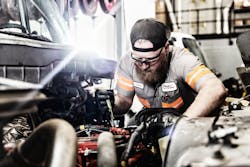As a totally decarbonized commercial vehicle industry inches closer each day, fleets can’t avoid adapting to the operational, infrastructure, and maintenance needs of EVs. But for the many trailblazers currently integrating zero-emission vehicles into their fleets, these changes are becoming a reality and so are the benefits and limitations of EVs. Ryder shares its insights on their EV transition journey so far:
When it comes to integrating electric vehicles (EVs) into a fleet, managers must always consider several factors: Will EVs work well for their duty cycles? Is there enough accessible charging infrastructure, or are they prepared to implement it themselves? Is their maintenance team properly trained in servicing this technology? And, at the end of all these questions, how are fleets meant to vet the trucks they'll be purchasing, when according to CALSTART, as of the end of 2022, fleets had 136 (non-pickup) choices to start their electrification journey.
Ryder, which runs the gamut of transportation solutions, from leasing and used sales to maintenance and supply chain management, has vetted a large swath of these solutions at every duty cycle, such as Freightliner’s eCascadia and eM2, as well as the MT50e chassis, and Navistar’s Lonestar EV (using Dana’s e-powertrain). Ryder also has reserved Tesla Semi tractors.
In the van segment, Ryder has Ford e-Transits, and by 2025 will lease up to 4,000 of General Motor’s BrightDrop Zevo 400 and Zevo 600 medium-duty electric vans. Add to that yard tractors, buses, and soon electric refrigerated trailers.
Read more: Ryder creates ‘turnkey’ EV fleet solutionAt ACT Expo in May, Ryder also launched RyderElectric+, which it calls a “turnkey electric vehicle fleet solution” to help fleets navigate the electrification process by bundling the vehicles, charging, telematics, and maintenance all for one price, with advisers available as well.
“We aim to help make the integration of electric vehicles as seamless as possible by offering solutions that are streamlined through one provider at one cost,” said Karen Jones, Ryder CMO and head of new product innovation at the unveiling.
Not all vetted solutions work out. As far back as the summer of 2017, Ryder was providing exclusive maintenance for Workhorse’s electric step vans and even started a short-term leasing program with the Workhorse C-Series in 2020. Production of that model halted on the heels of a recall due to reliability issues. Workhorse launched a new electric van, the W56, in March at Work Truck Week in Indianapolis.
Whether the EV heads into series production, as the eCascadia and eM2 have, or gets retooled by the OEM, Ryder gleans new insights. Fleets can purchase the comprehensive form of this wisdom via the company’s EV Shop startup guide.
Arun Chickmenahalli, director of maintenance and research and development for advanced vehicle technology at Ryder, said the strategy is a “clear path for the shops to adhere to—a process-driven approach while implementing EVs.”
He shared some of Ryder’s approach to vetting EVs and developing a maintenance program with Fleet Maintenance this spring.
For Chickmenahalli, proving EVs are reliable and that users develop “a good cadence for maintenance activities” will be critical to ensuring electrification succeeds. He said Ryder does extensive technical and OEM evaluations to discern which EVs offer customers the best value.
He noted while about two-thirds of an EV is the same as a conventional truck, the electric components that constitute the other third are quite different and servicers must start planning on how to adjust operations to accommodate them.
“The majority of OEMs” allow Ryder to perform diagnostics and in-house warranty work, Chickmenahalli noted, but some prefer to “learn for themselves” first. This creates a maintenance firewall, where Ryder isn’t sure what it will take to maintain these trucks.
“It is definitely restrictive for us not to be doing all the high-voltage work,” he offered. “In the interim, we should be learning.”
Each OEM does things a little differently—from battery chemistry to power management to charging—and that expands to each class segment. “There is not one simple process that you can follow for one technology,” Chickmenahalli explained.
Simple, no. But still possible. Ryder still needs to come up with maintenance plans for any vehicle it plans to lease or service, such as how to visually inspect for nicks in wire harnesses or corrosion on the battery.
Prior to an EV coming to a Ryder shop, the company executes an EV technician training plan, developed in conjunction with the OEM. This includes how to implement Ryder-developed tools, equipment, and PPE to ensure safety.
“Some of the training is very specific to their technology that will not be adaptable to another technology,” Chickmenahalli said.
Each shop gets a rollout guide and the responsibilities of each employee are laid out ahead of time.
Chickmenahalli follows a strict Six Sigma methodology and checks the progress of those shops through quality audits 60 to 90 days after “to see if they’re adhering to the policies and procedures.”
While this is going on, Ryder scores the EV on several fronts, such as issue resolution, diagnostics, field trials, production readiness, training and documentation, and vehicle communication. The technical evaluation questionnaire comprises 128 questions.
“We come up with a level of confidence with this OEM or a technology provider—basically a matrix that we define,” he said.
Even with this level of evaluation, Chickmenahalli said for Class 3 and higher, it will take one full lifecycle—5 to 7 years—to fully understand what it will take to maintain CEVs in terms of what components break down, how warranty repairs will work, the parts supply chain, and several other aspects.





